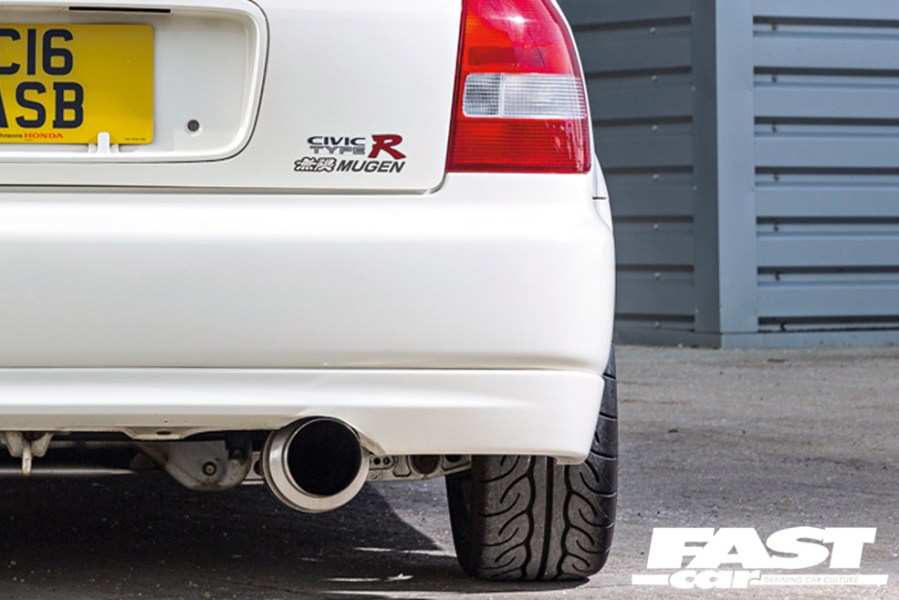Looking for the best exhaust for a Honda Civic Type R? Well, here’s some of our top picks from the performance aftermarket.
Often, the car’s exhaust is one of the earliest parts that enthusiasts choose to modify, and for good reason. Quite simply, you get a lot of bang (and sometimes pops) for your buck. Plus, not only will it drastically change how your car sounds, but there’s also some extra horsepower to be found if you choose your exhaust system wisely.
From the factory, older generations of the Honda Civic Type R had a pretty unique exhaust note thanks to their VTEC-equipped, naturally aspirated engines. Some people love the resulting sound, whereas others… don’t. Either way, the introduction of a turbocharger in the mid-2010s lowered the car’s signature high rev limit somewhat, giving it a less controversial (but also slightly less entertaining) exhaust note.
Whichever generation of Civic you have though, you can certainly enhance the way it sounds. The parts aftermarket for these cars is huge, so there’s no end of performance exhausts available. Here’s a selection of our favorites.
Best Exhaust for a Honda Civic Type R EK9

What’s it like as standard?
The Mk1 Honda Civic Type R (or ‘EK9’ to us nerds) was a major turning point for the perception of Honda as a performance brand. Although it looked like a humble grocery-getter hatchback, this pumped-up Civic was lighter, stronger, and much more powerful than your regular family runabout.
Amongst the car’s many desirable features, its party trick was undoubtedly its engine – the B16B. Used solely in this model, the B16B offered us our first glimpse at Honda’s now-renowned VTEC variable valve timing & lift control. Effectively, once the car reached a certain point in the rev range (in this case, 6,100rpm), its ECU would increase the level of valve lift, which in short equals more power.
This, coupled with the fact that the B16B was a naturally aspirated engine, meant that the EK9 Type R was blessed with an easily recognizable high-pitched exhaust note, accentuated by a noticeable change in character when VTEC kicks in.
Given that the EK9 was only sold in Japan in limited numbers, they’re quite tricky to get your hands on. However, if you’re in the market for one, be sure to check out our buying and tuning guides for the car.
Spoon
If you want to extract more performance from your Honda, Spoon is probably the first aftermarket company you should consider. This renowned performance tuner has been a Honda specialist for decades, ensuring to test each of their parts in actual races in Japan’s Super Taikyu motorsport series.
As far as street exhaust upgrades go for the EK9, you’ve got two main options – and actually, they’re fairly conservative by design. Whereas most of the exhausts we’ll feature in this article are cat-back systems, the Spoon N1 muffler ($710) is exactly that – just a muffler. You might also hear these referred to as ‘axle-back’ systems, as instead of including much of the pipework that runs down the length of the car, this package solely contains the rear muffler, which fits into place after the rear axle.
Admittedly, that does reduce the maximum potential for performance and sounds gains, but let’s not forget, the EK9 was a very specialized car to begin with. I mean, Honda even built it at Suzuka race circuit. As such, these Spoon mufflers enhance the sound of what was an already commendable bit of performance kit from the factory. Plus, by not having to fork out for a full exhaust system, you’re able to get your hands on premium Spoon parts without breaking the bank.
The N1 is the option to go for if you want the best sound possible from a muffler upgrade alone, while there’s also a ‘street’ variant ($928) for slightly more sociable sound gains. That said, if you do want to go all-out, Spoon does provide other elements of the EK9’s exhaust system separately. Check out their catalogue, here.
5zigen
You’ll do well to find an exhaust system with a more hyperbolic name than the 5zigen Miracle Fireball. However, don’t let that distract you from the fact that this 5zigen exhaust is actually pretty impressive.
The Miracle Fireball ($921) is a cat-back exhaust system, meaning you won’t fail any emissions tests. Plus, as it’s built from 1mm-thick stainless steel, 5zigen claims that it typically weighs about half that of the OEM equivalent on most of the cars they supply it for.
Finally, you also get a straightened pipe design, designed to aid the flow of exhaust gases, reduce back-pressure, and enhance performance. That straighter design is also good for sound quality, as you can hear for yourself in the video above.
J’s Racing
J’s Racing isn’t a brand that the average car enthusiast will have heard of, but for the JDM afficionados out there, it’s likely to spark a bit of excitement. This tuning house is a Honda specialist that made a name for itself on the Japanese automotive show, ‘Best MOTORing Hot-Version’. The show ran a long-standing touge battle competition between different tuners, J’s Racing being one of them.
Some of – if not the – most iconic cars to come from those televised touge battles were the J’s Racing Honda S2000s. In particular, one build became so well known that it earned its own intimidating nickname: ‘Demon King’. Featuring an extreme widebody and equally eye-catching livery, the car stood out not only for its looks, but also its serious pace.
Anyway, as you can gather from their presence on that show, J’s Racing is a formidable aftermarket performance brand. One of the exhausts that they provide for the EK9 Type R is the R304 SUS Exhaust 60RS ($641). Again, it’s a cat-back design, so is perfectly road-legal, and can even be spec’d with an additional inner silencer to keep things fairly toned down.
The exhaust system is stainless steel and only weighs 7.4kg, though it comes finished in a titanium-effect coating for a more exotic look.
Best Exhaust for a Honda Civic Type R EP3

What’s it like as standard?
The second generation of Honda Civic Type R, the ‘EP3’ was the first to officially be sold in Europe. However, any European Honda fans hoping to get a taste of the old EK9’s B16B engine would be left disappointed.
The new century heralded a new family of engines for Honda’s Civic model line-up, meaning that the B16B was out in favor of the new K20A. The new engine was still a high-revving four-cylinder though, so much of the Civic Type R’s core personality remained. In fact, over time, tuners came to love the K20 architecture just as much as the outgoing B16B.
Sound-wise, the EP3 offers plenty of the high-pitched magic that people associated with the EK9, though the crossover into the ‘VTEC Zone’ isn’t quite as pronounced. You’ll certainly still notice it though!
At the moment, EP3 Civics are still reasonably attainable, so if you’re in the market for one, be sure to read our buying and tuning guides.
Tegiwa x Milltek
The first exhaust system on our EP3 shortlist is the Tegiwa x Milltek cat-back ($867/£713), which Milltek constructs from T304L (a highly durable type of stainless steel). It features a 3-inch diameter pipe, which helps to provide commendable sound and performance enhancements.
Click the video above to hear the set-up for yourself. The folks at Milltek also provide a full run-down of the exhaust system’s dyno performance compared to stock – well worth a watch if you’re interested in how the product can make your EP3 quicker, as well as sound better.
Cobra Sport
Given that the UK & Europe was the primary market for the EP3-gen Civic Type R, it shouldn’t come as a surprise that there are multiple British tuners (like Milltek) that offer upgraded exhausts for it. Cobra Sport is another one.
The road-legal Cobra cat-back system ($700/£575) is a little more restrictive compared to the Tegiwa x Milltek, given that its pipe diameter is half an inch smaller. That said, it still offers sound and performance increases over the stock OEM part, and costs less than the Milltek system.
There’s an element of customizability about the Cobra exhaust too. As standard it comes with a circular tailpipe, but for around $50/£40 extra, you can specify it with an oval exit as seen in the video above.
HKS
If this Japanese hot hatch’s Swindon production line was already a little too UK-centric for you, then how about an exhaust system from HKS to inject some JDM magic back into it?
The HKS Hi-Power exhaust ($949/£840) is a tried and tested product that’s proven popular across multiple performance cars over the past couple of decades. Its straighter pipework allows for improved gas flow, equating to horsepower gains at higher rpm. The system also comes with an inner silencer, but you can remove it if you want to experiment with the sound.
To keep costs down, HKS only uses SUS304 stainless steel to construct the backbox, whereas the rest of the pipework underneath the car is formed from a milder type of steel. Due to the different densities of the material, this has a slight effect on the way that the car sounds too. Check out the video above to judge it for yourself.
Best Exhaust for a Honda Civic Type R FN2

What’s it like as standard?
Very little changed under the Civic’s hood between the EP3 and FN2 generations of the car. At the time, Honda fans were borderline outraged by the fact that the new FN2 had just a single extra horsepower over the EP3, while weighing in between 60-100kg heavier. Its bubbly exterior design did little to improve the car’s image, either.
That said, this controversial hot hatch eventually outgrew the hate, and developed its own smaller section of admirers. After all, you still get a naturally-aspirated, high-revving four-cylinder engine and playful front-wheel drive handling. And to be honest, compared to today’s cars, the weight is hardly much of an issue.
Expect a very similar exhaust note to the EP3, given that the two models run on largely the same engine.
To this day, the FN2 remains one of the least popular Civic Type R models around, despite its late renaissance in popularity. As such, you don’t have to pay too much to get your hands on one. Tempted? Make sure to read our buying and tuning guides for the car first!
Scorpion
Like the EP3, the FN2-gen Civic was definitely a Europe focused car. In fact, Honda didn’t even sell it in Japan – the domestic market got the more desirable FD2 sedan instead. As such, the majority of aftermarket exhaust systems for this car come from European tuning companies instead – like Scorpion.
Based in the UK, Scorpion offers a resonated dual-exit cat-back system for the FN2, priced at $774/£636. The system features a 2.25-inch pipe diameter, is hand-crafted, and fits correctly in line with the stock rear diffuser.
Check out the video above to hear how the Scorpion exhaust compares to the standard OEM part!
Martelius
Finland isn’t often a country that’s associated with aftermarket performance parts, but Finnish brand Martelius offers a cracking pair of exhaust systems for the FN2 Type R.
The pipework used in this kit has a slightly wider diameter than the Scorpion package, measuring in at 2.5 inches, and also comes in two different variations. The single-pipe exhaust system ($558/£457), as shown in the video above, leaves the right exit empty in favor of a straighter pipe flow, and as you can hear, it sounds markedly different to the standard car.
Martelius themselves do admit that you can sometimes get a bit of unwanted drone come through into the cabin though at motorway speeds, but that’s not a problem with the slightly pricier dual-pipe variant of this exhaust ($752/£616).
Despite the mean sound, both systems are cat-backs, meaning you won’t fail any emissions tests.
Milltek
The Milltek cat-back kit ($1089/£892) for the FN2 Civic Type R is non-resonated, making it louder. It’s also a dual-pipe design, intended to make use of the stock OEM tailpipes – so don’t throw them away!
Crafted from T304 stainless steel, the Milltek cat-back has a 2.5-inch pipe diameter to aid gas flow for better sound and performance, while its straighter-than-stock layout works towards the same goals.
If you’d like to know what that translates into in practice, make sure to watch the video above!
Best Exhaust for a Honda Civic Type R FK2

What’s it like as standard?
After a short hiatus following the FN2, the Honda Civic Type R returned for a two-year production spell between 2015-2017. The ‘FK2’ Type R came with much wilder aero from the factory, and that’s not all that was new.
Under the hood, the FK2 ditched its naturally-aspirated roots in favor of a turbocharger. As such, its four-cylinder engine could now provide *a lot* more power, and do so while still complying with increasingly tighter emissions regulations. The downside was that a lot of the charisma was lost from the way the car sounded, which – arguably – was one of the main draws of early Type Rs.
As such, it’s fair to say that while the FK2 is a fine performance car, it never really developed much of an identity. So, if you want to give your one a bit more character, perhaps its time for an aftermarket exhaust…
Looking to buy an FK2, or learn about how to tune one? Give our dedicated guides a read.
Armytrix
Armytrix tends to cater towards high-end supercars and luxury vehicles, yet it decided to make an exception for the FK2-gen Civic Type R.
This exhaust system ($4087/£3348) is quite a comprehensive one, removing the stock catalytic converter and replacing it with a high-flow sports cat, as well as redesigning the rest of the pipework and muffler. As a result, Armytrix quotes an approximate 14PS power increase, as well as an extra 12lb ft of torque. Crafted from aluminium, this exhaust system system weighs 3.5kg lighter than the standard kit too.
What’s more, the exhaust even features valve technology, allowing you to raise or lower the car’s volume at the push of a button. This is achievable via the Armytrix key fob, or phone app. Pretty cool, huh?
Watch the video listed above to hear the difference for yourself.
Remus
Next up is Remus. Like the Armytrix exhaust mentioned previously, this Remus system ($3268/£2677) uses valve technology to alter the volume of the exhaust note remotely, via a key fob. However, as it’s only a cat-back design, it won’t cost you as much money as the Armytrix. Admittedly, the gains therefore aren’t as large as that of the Armytrix kit, but an extra 10PS and 9lb ft of torque isn’t to be sniffed at.
Plus, as you can hear for yourself in the video above, the sound of the car is noticeably more aggressive, especially with the valves turned open. By design, these turbocharged Civics are a little deeper and more muted in tone, yet the Remus exhaust still manages to make the core ingredients sound fairly sporty.
Scorpion
What if you need an exhaust upgrade for the FK2 that’s a bit more attainable, price-wise? Well, you may want to consider the Scorpion resonated cat-back, which makes do without switchable valves, and therefore is significantly cheaper.
Priced at $1633 (£1338), the Scorpion system is still a sizeable investment, but stands as one of the best value for money exhaust upgrades around for the FK2. Expect performance gains of around 10PS, and around 5kg of weight saving compared to standard.
As you can hear in the video above, the system definitely has some audible presence, yet it’s not too unsociable either due to its resonated design. However, if you want to go a bit more hardcore, Scorpion also supplies an additional turbo downpipe with sports-cat for $753 (£617). The de-catted version is cheaper, but beware that it won’t pass emissions regulations, rendering it unroadworthy.
Best Exhaust for a Honda Civic Type R FK8

What’s it like as standard?
Given how acclaimed the Civic Type R badge is worldwide, it might surprise you to know that the nameplate didn’t reach the United States until the fifth-gen ‘FK8’ iteration came out in 2018.
An undeniable global success, the FK8 Type R picked up where the FK2 left off from a performance point of view, and turned the recipe into arguably the best FWD hot hatch package on the market, if it wasn’t already. Now well into the ‘turbocharged era’ of compact performance cars, the snail remained under the hood of the Civic in its FK8 guise. So again, these aren’t quite as high-revving as the first three models.
Happily though, as the FK8 has a truly global presence, there is an abundance of aftermarket exhaust options out there which aim to eke out a bit more performance, and a better sound. Like, seriously, there’s loads of them out there. For now though, we’ve rounded it down to just three brands that we think are most worth considering.
Looking to buy an FK8, or learn about how to tune one? Give our dedicated guides a read.
GReddy
Like most tuning companies, GReddy manufactures multiple different exhaust systems for the FK8-gen Civic. The two that we’re focusing on here are the DD-R cat-back exhaust ($1050), and the Supreme SP High-Grade cat-back ($1795).
Let’s start off with the DD-R. This is a modern reinterpretation of some of GReddy’s dual-pipe exhausts of the past, created from T304 stainless-steel. The pipework has been designed to flow as straight as possible, while its 3-inch diameter also aids the travel of gas. Customizability is a desirable aspect of this system, given that you can chop and change the tips and silencers for more control over how the exhaust looks, flows, and sounds.
Alternatively, the GReddy Supreme SP HG is a more premium product. Instead of two central exits, the Supreme SP makes use of three. That isn’t just a styling choice either. GReddy’s tri-pipe design has been created with optimal sound and gas flow in mind. The system also features a resonator and peripheral ‘sound chambers’ to keep unwanted drone to a minimum. Like the DD-R, the Supreme SP HG’s pipework is 3 inches wide in diameter, and constructed from T304 stainless steel.
Check out the video above to hear how they compare.
HKS
Two more exhaust options for the FK8 Civic come from HKS. In the video above, the white FK8 is running the HKS Legamax Premium exhaust ($2124/£1740), while the blue FK8 has the HKS Hi-Power Spec L ($1889/£1548). However, when watching the comparison, keep in mind that both cars have been de-catted, meaning they’ll be louder than what you can expect from your car if it’s still got the cat. That said, this will give you a good impression of the differences in tone between the two exhaust systems, at the very least.
Beyond what your ears tell you, here’s the nerdy specs for both systems. Starting off with the Legamax, this exhaust system is actually the same weight as the standard OEM part, however it’s got a much wider pipe diameter (3 inches) and straighter flow, reducing back pressure by 50%!
Meanwhile, the Hi-Power Spec L is nearly 6kg lighter than both the Legamax and standard Honda exhaust system. It also provides a happy middle-ground in terms of volume between the two as well. So, while you won’t get quite such an entertaining exhaust note as you will with the Legamax, you’ll benefit from a more refined ride when just commuting.
Tomei
To finish things off, here’s three different options in one video. Don’t say we never treat you…
Tomei is a renowned JDM tuning brand with decades of experience of manufacturing upgraded performance parts, not only for the street, but for racing too.
In regards to their products for the FK8 Civic, we’ll be focusing on the aptly-named Tomei Expreme Ti Type R exhaust ($1390), as well as its Type S ($1390) and Type D ($1890) counterparts.
Each of the three variants are significantly lighter than stock, but it’s the ‘R’ which is the lightest, tipping the scales at just 7kg. The Type S weighs 10kg, while it’s 13kg for the Type D – though that’s still around 4kg less than OEM. Each of them are titanium, which is surprising given their reasonable price tags.
In simple terms, imagine these systems as a sliding scale. The Expreme Ti Type R exhaust is the loudest, most performance-oriented, whereas the Type D is the most civil. Type S sits between the two. It’s also worth pointing out that both Type R and Type S utilize a single exit, whereas the Type D is a dual-pipe design. For the full spec run-down, click here.
How to buy the best exhaust for a Honda Civic Type R
An aftermarket exhaust is a must for any enthusiast who loves spirited driving – you’ll never want to leave the throttle pedal when your car is on full song. Love it or hate it, that’s especially true for the older N/A non-turbo VTEC Civics. But, before you splash the cash, there are a few factors you need to consider when upgrading. Firstly, why are you upgrading your exhaust? Is it for extra performance? Perhaps it’s just an increase in volume you’re after. Or maybe you want more performance *and* more sound. The first thing to consider, and is the same principle you should use when upgrading the exhaust on any car, is the diameter of the exhaust pipes. If you’re planning on modifying other performance parts, an increase in size can be a good option.
As for sound, how do you plan on using the car? If you’re looking to utilize the Civic’s on-track prowess, you’ll be needing a free-flowing exhaust but one with silencers to adhere to noise limits. If you’re just driving on the road, the world is your oyster. Although too loud and you’ll have the Police to deal with…
Exhaust material
Finally, the material of the exhaust. On the GT-R models, it’s not uncommon to find titanium exhausts as readily-available as stainless-steel, such is the diversity of the Skyline tuning scene. Titanium exhausts will change the pitch of the engine note ever-so-slightly, so if you’re wanting something with more rasp at the top end, aim for titanium. It’s more expensive, guaranteed, but they’re lighter and produce an epic sound. In terms of performance, a titanium exhaust in itself won’t improve your topline figures, that’s down to the exhaust flow.
Still in need of some inspiration? Check out our top Honda Civic Type R feature cars!





